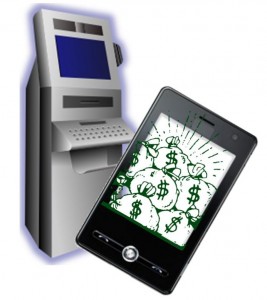Recent data released by the Halifax Bank of Scotland revealed that this preference is maintained in-branch.
The most recent indication that mobile banking is becoming increasingly popular and that the traditional form of banking by lining up and speaking to a human teller is on its way out, has now been released in the form of some interesting data from Halifax Bank of Scotland.
What it showed is that customers would rather use their smartphones or an ATM than speak to staff.
In fact, that preference is strong enough that customers would still rather use mobile banking or an automated machine, even when they’re in a bank branch. The vast majority of interactions that customers have with their banks are over devices such as smartphones, tablets, laptops, and automated teller machines. In the branches, themselves, over half of the visits will include the use of one of the self service machines in order to pay using checks or cash. These are frequently chosen over the opportunity to speak with the human cashiers and other staff members.
Usually, mobile banking and other automated services are selected unless more detailed assistance is needed.
 It appears that consumers would prefer to use devices whenever possible, and that staff members are consulted only when complex products (such as mortgages, for example) or detailed financial advice is required.
It appears that consumers would prefer to use devices whenever possible, and that staff members are consulted only when complex products (such as mortgages, for example) or detailed financial advice is required.
Online accounts are accessed by mobile devices and laptops far more frequently than branch visits are made. In fact, the data from Halifax showed that it had experienced 69 million interactions with consumers throughout the month of June, at a daily average of 2.3 million. This is an increase of 47 percent over the same month, the year before. This indicates that not only are people choosing to access their accounts online, but they’re accessing them more frequently than ever4 before.
Among those interactions, a massive 57.2 percent were made over the mobile banking app, as consumers increasingly use their smartphones and tablets for making payments and checking balances while they’re on the go. Another 29.4 percent used desktops and laptop computers to do the same thing. Only a tiny 10.3 percent of the interactions were actually branch visits and an even smaller 3 percent contacted their bank by phone.
This age group is among the early adopters of this type of authentication technology, says the USAA.
The USAA financial services company has recently discovered that its biometric authentication technology for its mobile banking services has achieved popularity in an interesting and unexpected group of the population.
What it has found is that it is seniors who are among the most likely to be early adopters for this mobile security tech.
What the USAA’s figures showed was that among the over 400,000 customers that have opted into using voice, facial, or touch biometrics mobile security technology, the average age is 35 years old. That said, among those mobile banking users who are above that median age, a sizeable 15 percent are seniors (people over the age of 65 years old). That said, it even recorded that there were 5 users who were over the age of 90 years.
This mobile banking security trend is quite an interesting one, as this type of tech is usually associated with the very young.
 The fraud operational excellence and strategic initiatives executive at the USAA, Rick Swenson, shared the demographic parsing at a roundtable discussion that had been held by the Center for the Study of Financial Innovation, in London. The USAA first began its use of biometrics through voice and facial recognition, in February. Inside of a month from the launch of this optional security verification feature, there had been 200,000 members who were enrolled.
The fraud operational excellence and strategic initiatives executive at the USAA, Rick Swenson, shared the demographic parsing at a roundtable discussion that had been held by the Center for the Study of Financial Innovation, in London. The USAA first began its use of biometrics through voice and facial recognition, in February. Inside of a month from the launch of this optional security verification feature, there had been 200,000 members who were enrolled.
In April, the USAA added fingerprint authorization to its mobile security biometrics options. According to Swenson, developing these biometrics options was not an expensive venture. He compared it to the cost of developing remote deposit capture tech (in which smartphones can be used to take a picture of a check in order to deposit it into their accounts).
That said, it does make sense that seniors would be among the first to adopt this mobile banking security option. According to communications consultant Keith Gold, formerly of IBM Banking and Financial Services Europe, this type of authentication could be very appealing to people who could potentially struggle to remember a PIN or password whenever they needed it, or who might struggle to be able to type it into a smartphone using the tiny digital keys of a touchscreen keyboard.
 It appears that consumers would prefer to use devices whenever possible, and that staff members are consulted only when complex products (such as mortgages, for example) or detailed financial advice is required.
It appears that consumers would prefer to use devices whenever possible, and that staff members are consulted only when complex products (such as mortgages, for example) or detailed financial advice is required.
 The fraud operational excellence and strategic initiatives executive at the USAA, Rick Swenson, shared the demographic parsing at a roundtable discussion that had been held by the Center for the Study of Financial Innovation, in London. The USAA first began its use of biometrics through voice and facial recognition, in February. Inside of a month from the launch of this optional security verification feature, there had been 200,000 members who were enrolled.
The fraud operational excellence and strategic initiatives executive at the USAA, Rick Swenson, shared the demographic parsing at a roundtable discussion that had been held by the Center for the Study of Financial Innovation, in London. The USAA first began its use of biometrics through voice and facial recognition, in February. Inside of a month from the launch of this optional security verification feature, there had been 200,000 members who were enrolled.